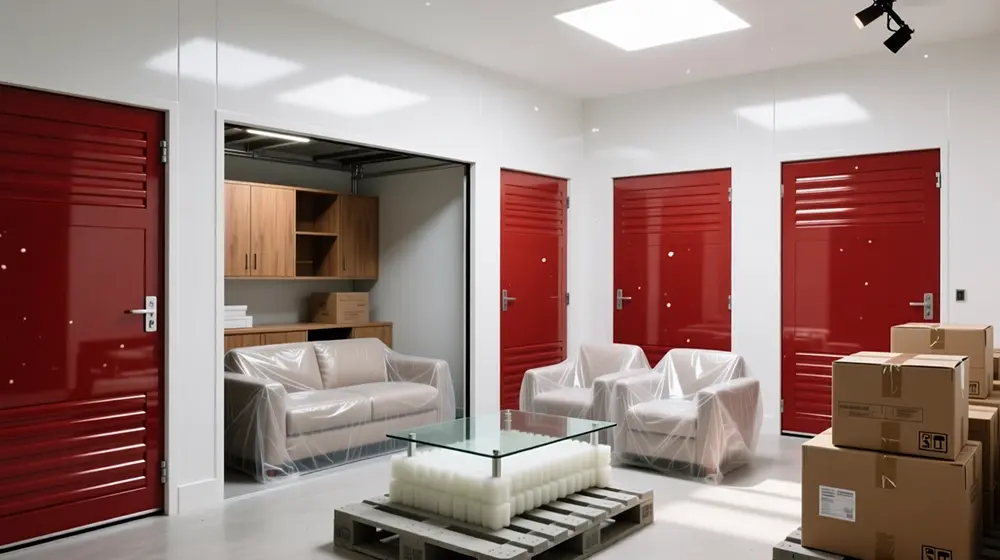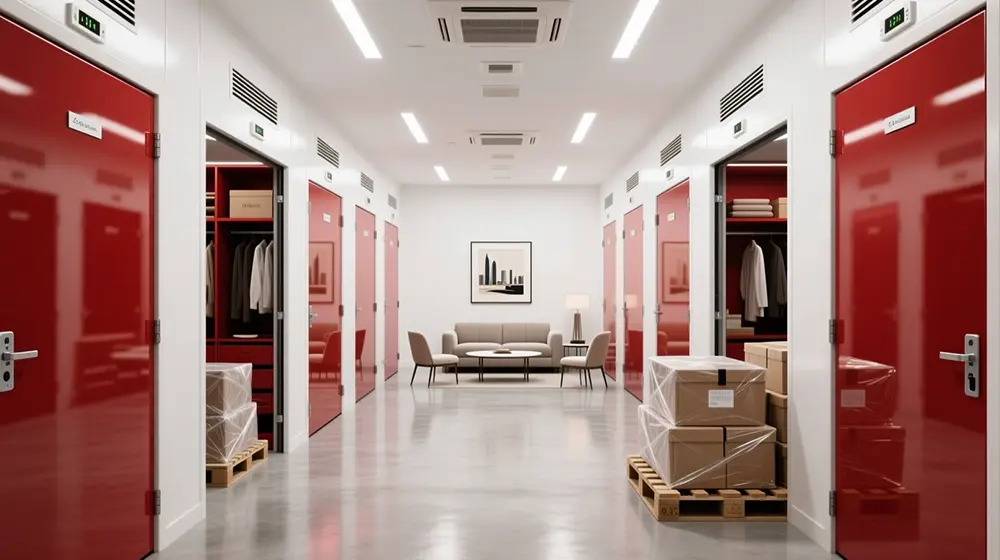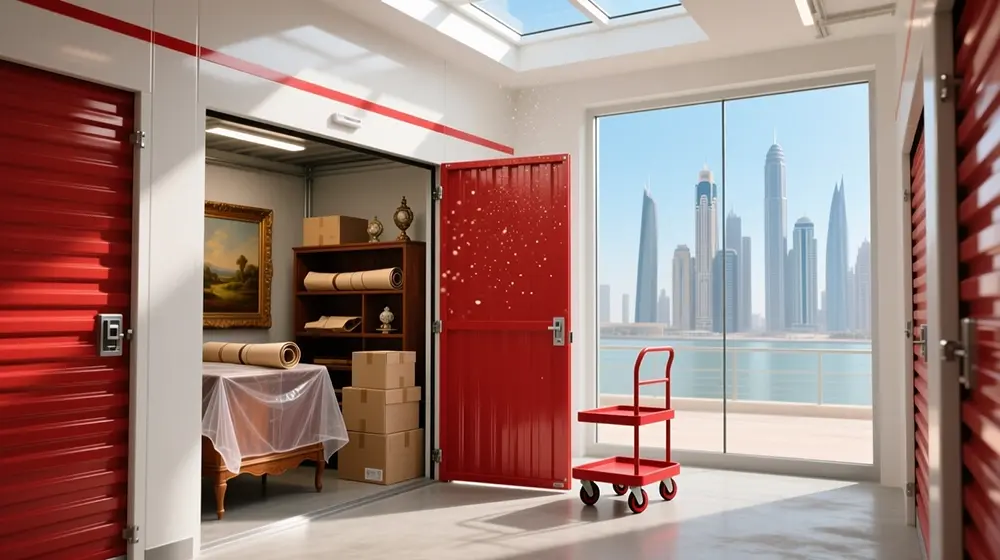The furniture storage of Dubai Marina and JBR residents has to be precisely sized due to the fact that the waterfront apartments are built on tight floor plan, high-format furniture, and small storage area per unit. Both districts have high-rise residential towers that are open-plan with living rooms and have a narrow utility closet and face the outlet, which diminish the available storage area indoors. Included in the L-shaped sofas, king- and queen-size beds, full dining sets, and Outdoor Balcony furniture are items which often surpass the storage capacity of the built-ins during any given move, renovating, or seasonal change. The distance between Marina and JBR is relatively short to facilitate transfers in a short period, yet storage planning needs proper furniture sizes measurement, climate factors (because of the coastal climate), and the selection of units with a proper size to avoid overcrowding and damages. This guide contains an elaborate framework of sizing, item-by-item measurements rule and store unit suggestions that are specifically designed on the waterfront apartments of Marina and JBR.
Why do Marina and JBR residents require precise furniture storage sizing?
Residents of Dubai Marina and JBR require precise furniture storage sizing because their waterfront high-rise apartments feature compact internal layout, minimal in-unit storage options and frequent space constraints. In tower apartments, built-in wardrobes and utility rooms are smaller than villa equivalents. Furniture deliveries often arrive earlier than move-in dates or during renovation periods. Without accurate sizing, residents risk renting too large a unit (wasting money) or too small a unit (creating overcrowding and potential damage to items).
How do Marina and JBR apartment layouts influence storage requirements?
The layout of Marina and JBR apartments influences storage requirements by limiting available in-home space while exposing residents to frequent turnover and seasonal changes. Apartments in these waterfront districts often have open-plan living rooms, balconies with views, and bedrooms sized to maximize view rather than storage capacity. Residents may own large L-shaped sofas, full dining sets, bulky lounge furniture and mattress sizes suited for high-end living. These bulkier items exceed typical built-in storage capacity, thus off-site storage becomes necessary. Additionally, many residents lease apartments short-term or move frequently, which adds to the need for flexible storage sizing.

What furniture categories require dedicated storage for Marina–JBR moves?
Furniture categories that typically require dedicated storage for residents of Marina and JBR include sofas, sectionals, beds and mattresses, dining sets, wardrobe and storage units, balcony and outdoor furniture, large mirrors or artwork, and electronics-mounted furniture. For example, three-seat sofas usually range from 183-244 cm (72-96 inches) in width. Standard depths for sofas often fall in the 90-100 cm range. Beds and mattresses come in large footprints (queen, king, super-king sizes). Dining tables for four to six chairs often measure between 180-220 cm in length. Outdoor balcony sets add further bulk. Each of these categories demands measurement and space allocation when selecting a storage unit.
What storage unit sizes match typical Marina and JBR apartment furniture volumes?
In Dubai storage market guides, typical unit sizes and their match to furniture volumes are as follows:
- A 25-30 sq ft (≈2.3-2.8 m²) unit is suitable for minimal overflow, such as boxes, small furniture items, chairs or side tables.
- A 50 sq ft (≈4.6 m²) unit matches the contents of a light one-bedroom apartment: a three-seat sofa, queen mattress, TV unit and decorative boxes.
- A 75-100 sq ft (≈7-9.3 m²) unit suits a larger one-bedroom or compact two-bedroom apartment in the Marina/JBR area: an L-shaped sofa, king mattress, dining table, wardrobe units and balcony furniture.
- A 125-150 sq ft (≈11.6-14 m²) or larger unit is recommended for full 2-bedroom households with multiple large pieces including full sets of furniture, large sofas, multiple wardrobes, appliances and balcony/outdoor furniture.
These sizing guidelines allow residents to allocate space efficiently without over-paying for huge units or squeezing items into undersized units where stacking may damage them.

Why do waterfront apartments require climate-controlled furniture storage?
Waterfront apartments in Marina and JBR require climate-controlled furniture storage because the coastal environment exposes items to higher humidity, salt-laden air and rapid temperature variation. Elevated humidity affects wooden furniture by causing expansion and warping. Upholstered items and mattresses absorb moisture more readily and can develop mould if left in uncontrolled environments. Metal components in furniture or mounted electronics may corrode due to salt aerosol exposure. Climate-controlled units maintain stable temperature and humidity conditions, thereby preserving the structural integrity, finish, upholstery and lifespan of large furniture items and household sets.
How should Marina and JBR residents measure furniture before selecting a storage unit?
Residents should follow these measurement steps to choose the correct storage unit size:
- Measure the length (L) of the largest furniture piece, from outside edge to outside edge.
- Measure the depth (D) of that piece, from front edge to back edge.
- Measure the height (H), from floor to highest point (often sofa back or wardrobe top).
- For beds and mattresses, note exact mattress size (e.g., queen 150×200 cm or king 180×200 cm) and measure the packed footprint if stored on its side.
- Add an allowance of 5-10 cm (2-4 inches) to each dimension to accommodate wrapping, padding and clearance for airflow.
- Sum up cubic volume if stacking vertically will be used (floor area × height) and check unit internal height (commonly 8-10 ft / 2.4-3 m).
- Map out an approximate layout of large items on paper or using digital tools to visualise how many units you might need or how best to stack.
By measuring precisely, residents avoid under-estimating space and ensure they hire a unit where large items fit safely without forced stacking or item damage.
How should furniture be packed for Marina–JBR storage transfers to resist coastal conditions?
Furniture should be packed with the following clear protocol:
- Clean all furniture surfaces to remove dust and possible salt residues.
- Upholstered items should be fully dry before packing to prevent trapped moisture.
- Use breathable covers made of spun-bond polypropylene or similar fabrics for sofas, mattresses and large furniture pieces. These covers permit vapour transmission and reduce internal condensation.
- Disassemble removable parts wherever possible (e.g., table legs, sofa chaise, bed frames) and store components in labelled bags.
- For wooden furniture pieces, apply corner protectors and wrap in padding; avoid plastic wrap that may trap moisture against surfaces.
- For large glass-top dining tables or mirrors, wrap with bubble wrap, then layer with a breathable sheet and secure upright if possible to prevent flat stacking.
- For metal furniture and frames, wipe with a dry cloth and consider corrosion-inhibiting paper or VCI (volatile corrosion inhibitor) film if available.
- Pack electronics-mounted furniture or media units in sections with silica-gel desiccant packs inside sealed anti-static aluminium or metallised barrier bags, then store in cardboard or laminate boxes.
- Label each item clearly with orientation arrows, item description and date packed for easier retrieval and lower risk of damage.

This method ensures large furniture items remain protected from moisture, salt and temperature swings when transferred from a waterfront apartment to storage.
Also Read : furniture storage in abu dhabi
How does proximity between Marina and JBR improve storage logistics?
The proximity of Dubai Marina and JBR improves storage logistics by enabling quicker transfers, shorter transport times and lower exposure to outdoor conditions. Both neighborhoods are located along the Jumeirah Beach shoreline with direct road and pedestrian links; travel times between central buildings in Marina and JBR often fall under five minutes by car. This quick turnaround means furniture can be loaded, transported and placed into the storage unit within the same day, reducing time items spend outdoors in humid air. Faster logistics also reduce the chance of delays that can result in items sitting in corridors, elevators or external loading zones where environmental exposure is higher.
What moving patterns create demand for storage during Marina–JBR transitions?
The high turnover nature of Marina and JBR apartments creates significant demand for furniture storage during transitions. Patterns include:
- Residents moving in or out on short-term leases needing temporary storage of large pieces until next occupancy.
- Renovation periods where furniture must be cleared from apartments for painting, flooring or balcony work.
- Seasonal overflow where residents alternate between indoor and balcony furniture or rotate lounge sets.
- Delivery mismatches where large items arrive before installation, requiring interim storage.
- Downsizing moves where residents hold select furniture while deciding on final unit size or layout.
These patterns drive the need for storage units that are appropriately sized, flexible in terms of duration and located close to Marina / JBR.
How does correct storage unit sizing prevent damage during Marina–JBR moves?
Sizing storage units properly helps avoid damage during Marina-JBR moves since storage space is appropriately sized such that items are placed without being forced to stack, air can circulate around items, and items can be safely positioned (eg. mattresses stacked on the side, sofas placed upright). Small sizes tend to overload units, causing hard items to be packed overcrowded and this packs upholstery, exerts stress on conveyor joints in furniture, causes a likelihood of scratching, and makes them less accessible. Big units are more expensive, yet might also cause items to be unpacked and move around on the delays. Sizable units provide the stability of items, their accessibility and protection against external factors.
Also Read : Short-term storage during Dubai Marina renovation projects
Summary: How proper storage sizing improves Marina–JBR moves
Sizing the storage area to suit the bulk and volume of high-end apartment furniture enhances the storage of Marina-JBR furniture so that the items are not exposed to the coastal humidity and the furniture can be transported with ease across the waterfront areas. The inhabitants of Marina and JBR will benefit by being able to count accurately, pick the size of the unit that fits (in the case of a sofa+bed setup 50 sq ft, in a case of a bigger two-piece set, 75-100 sq ft), use climate-controlled storage, correctly pack heavy furniture, and take advantage of the fact that Marina and JBR are near each other, which means that the furniture can be delivered immediately and put in a storage unit. This integrated approach will guarantee that furniture is not damaged, and it is available and can be retrieved when needed.






